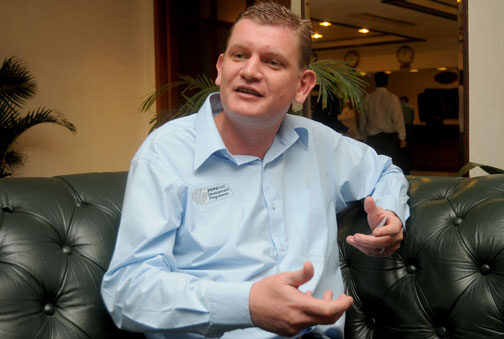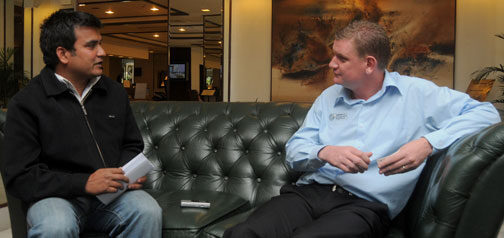
Matthew Kennedy, the ICC Global Development Program Manager. Photo Courtesy Bikash Karki/Republica
Matthew Kennedy, the ICC Global Development Program Manager, is in Kathmandu for the Pepsi ICC World Cricket League (WCL) Division 5. He joined International Cricket Council (ICC) in 2000 and has been serving in the current position since January, 2004. On Thursday, in between his meetings, Kennedy talked with Cricket Nepal about the Program and the tournament. Excerpts:
Cricket Nepal: Let’s begin with the ICC Global Development Program. What it is?
Matthew Kennedy: The ICC Development Program began in 1998 and it’s a global program broken into five regions. So, there is five regional development program based in Melbourne for East Asia Pacific, in Kuala Lumpur for Asia, in Toronto for America, in Johanesburg for Africa and London for Europe. The aim of the Program is to try and promote cricket in 94 Associate and Affiliate member countries.
What are the activities of the program?
The program is split into five sections. The High Performance Program (HPP) which is about focusing on best six Associate members and try to bridge their gaps to the Full members. There is a regional development program which concentrates on junior development, education of coaches and umpires, facilities development as well as regional competitions.
There is a development event section, which looks after WCL, that’s why we are here in Nepal this week, the Intercontinental Cup, the Intercontinental Shield and the World Twenty20 qualifier which happened in Dubai last week.
There is women’s cricket development as a standalone function across all the regional regions. And, there is member support and comply function which is assisting members to have plans and budgets so they can make and achieve their objectives and goals.
It has been more than 12 years since the program began. What are its achievements?
In that time, we had 45 members at that time, now we have 104 members and that’s a significant growth. It has been only 4-5 years since we integrated women’s cricket. But without a doubt, the biggest achievement in the period is the development of international competition structures: the WCL and the Intercontinental Cup. And, [there is] the opportunity and access for every member to work their way through regional competitions into the WCL, and if they are good enough, all the way through to the World Cup or the World Twenty20.
The top level of cricket is confined in a few nations. How do you see the top level expanding?
It all comes down towards trying to ensure the HPP plays a big role and making the countries strong enough to surprise, and consistently doing so, at the highest levels. In every country, it’s a different approach. In some countries where cricket is popular, like in Nepal where people know what cricket is, and in some other countries where cricket is not so popular as some other sports; so we have different approach and programs what we are trying to achieve.
To go at the top level, the countries have to become strong enough on the field by having good participation, structure and education.
Is it your first visit to Nepal?
Actually no. I have been here to participate in an ICC Development Committee meeting here in November 2005. That was brief.
How do you evaluate Nepal’s hosting of the WCL Div 5?
The Cricket Association of Nepal (CAN) and all the volunteers have done a fantastic job. It’s not easy to put on an international tournament like this. So the venues were fantastic and it’s exciting when you go to the field. I had meetings all way, but certainly I have been at IOE and TU for a half-day each, and I am sure that there will be fantastic environment tomorrow [Friday] at all grounds as there are interesting matches.
Do you think the decision to hold the event in Nepal was a wise one?
Definitely. Nepal has put on a fantastic event. There is still two days to go but the promotion, the support of the media including the live broadcasting on television, is quite unique to Nepal. There are not many associates that could have achieved it.

Cricket Nepal's Ujjwal Acharya interviewing Matthew Kennedy. Photo by Bikash Karki
Do you see the performance of the teams in WCL improving?
I think we are at the crossroads of the WCL. We are still at the early stage of the WCL with the promotion/relegation throughout the world. It will still take a few years for countries to find their positions. We will certainly see them settle down soon and the countries will challenge to go to the next level or be challenged by the lower division team. This is going to make it really exciting cricket.
What WCL does is it provides any team to progress all the way. An example is Afghanistan [Afghanistan went all the way to Division 2 from Division 5].
How Nepal can improve?
Exactly what it seems it is doing now – work way up the ladder. Nepal historically has some very good results at U-19 level in past six to seven years. I think the big challenge for Nepal is to translate those successes at the junior level into the senior team and the senior team should really have an ambition to break into the top 10 of the associate and affiliates nations. I know there are plans to do that.
There have been some criticisms to the program. The first is of course ICC focusing more on commercialization of the sports than the development. How do you refute it?
There is no need to refute it. In term of commercialization of the games, the ICC has broadcast partners and sponsorships with all major events. And, all the money is distributed towards all members that why country like Nepal and USA have the funding, which has tripled in past 12 months. From 2008 to 2009, there is a huge jump in the support that the ICC is able to give to countries.
All funding mechanism to all our members is based on the funding policy and we try to help everybody reach their potential and create new markets.
Yet another criticism is that the program is not concerned about developing homegrown players at the time when some of the nations are competing with expatriates only. What you have to say?
In terms of the national team, we have a very clear rules which says you need to be national of the country or living and playing cricket in the country for past seven years and you can only have two players who have played in the country for last four years. So, those rules are consistent for everybody. The key is not so much about making of the national team, in my view as long as they are eligible by rules, they are eligible to play at the ICC.
The key to development of the game is to make it sustainable. In different country, there is different makeup. In some, expatriate population has played really an important role in making cricket sustainable.
Do you see that in future the program helps to get more homegrown players?
Almost, there are may be second generation immigrants from the Test-playing countries but in future we will see many people born and grown in the country working their way to the system. The growing number of active participant number is showing that.
